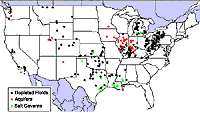Issued on: September 11, 2003
DOE, Penn State To Establish Gas Storage Technology Consortium
Goal is to Improve Performance of the Nation's Underground Gas Storage Infrastructure
 |
FOSSIL FACT: The nation's gas industry stores natural gas in more than 400 underground storage reservoirs and salt caverns throughout the country. Click here for larger image
|
University Park, PA - The Pennsylvania State University has been selected by the U.S. Department of Energy to establish and operate an underground gas storage technology consortium.
The agreement between Penn State and DOE's National Energy Technology Laboratory Strategic Center for Natural Gas will last four-and-a-half years at a total cost of $3 million. The first phase of the agreement will last 18 months to allow creation of the consortium structure, solicit membership and establish an executive panel of industry experts, refine a technical approach for deliverability enhancement and reservoir management research, and select and award the first round of research projects.
The consortium will be industry-driven, and emphasize the creation of a balanced research portfolio of practical solutions, short-term projects, and basic research to improve the performance of the nation's gas storage infrastructure.
Most natural gas produced in the United States requires long distance transmission to reach its ultimate end user. The nation uses 1.5 million miles of natural gas pipelines capable of moving 111 billion cubic feet of gas daily to service customers. However, the need for gas fluctuates more quickly than can be accommodated by the production and pipeline systems. In general, demand varies seasonally, but the exact timing and magnitude of peak demand is determined largely by the weather, and is therefore unpredictable.
To manage this risk, natural gas is injected into more than 400 underground storage reservoirs and salt caverns each year from April through October. These storage reservoirs and caverns provide roughly 4 trillion cubic feet of gas to help meet both seasonal and peak demands. Together, natural gas pipelines and underground gas storage create a distribution system that efficiently balances the need for steady year-round gas production with seasonal variations in demand.
That efficiency will be tested in the years to come as natural gas demand is expected to grow from 22 trillion cubic feet per year today, to almost 35 trillion cubic feet by 2025. This demand will be met by increased production of domestic natural gas from both conventional and unconventional sources, as well as growth of a true world market for liquefied natural gas. The expansion in both the volume and nature of gas use will place significant new burdens on the nation's existing pipeline and storage systems.
Gas storage research focuses primarily on two main issues. First, gas storage wells/fields often suffer a decline in productivity after several years of withdrawal and injection cycling. Current revitalization techniques usually provide only limited, temporary delivery restoration. Second, not all regions of current and potential high gas demand possess natural underground reservoirs or salt formations that can support local storage needs.
Research supported by the consortium will include, but not be limited to, technologies to limit and remediate the progressive damage caused by the repeated injection and withdrawal of gas in existing and future facilities, as well as innovative reservoir development and management techniques that can maximize performance. Moreover, research will focus on developing, in close proximity to demand centers, man-made storage systems such as underground mined caverns, gas hydrate storage, distributed liquefied natural gas, and other non-traditional means.
-End of TechLine -
For more information, contact:
|